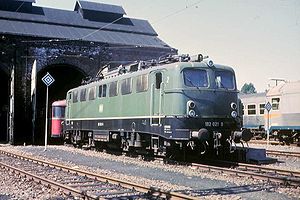DB class E 320
| DB class E 320/182 | |
|---|---|
|
182 021 in the home depot Saarbrücken in 1982
|
|
| Numbering: | E 320 01, 11, 21; from 1968: 182 001, 011, 021 |
| Number: | 3 |
| Manufacturer: | AEG , Krupp |
| Year of construction (s): | 1960 |
| Retirement: | 1982 |
| Axis formula : | Bo'Bo ' |
| Length over buffers: | 16,440 mm |
| Service mass: | 82 t |
| Top speed: | 120 km / h |
| Hourly output : | 2760/2488/2550 * kW |
| Continuous output : | 2460/2320/2340 * kW |
| Starting tractive effort: | 30600/28000/28000 * kp |
| Power system : | 15 kV 16⅔ Hz ~ 25 kV 50 Hz ~ |
| Number of traction motors: | 4th |
| Type of speed switch: | 182 001: Low-voltage switchgear MHS 1 from AEG with 2 flat-track selectors with hydraulically operated selector contact, 2 load switches and 2 transducers
182 011: NO 32 from BBC with rotary selector, 3 load switches and transition resistor 182 021: W 40 SL from SSW with rotary selector, snap load switch and transition resistor |
| Locomotive brake: | el. drag brake |
The electric locomotives of the E 320 series , from 1968 the 182 series of the Deutsche Bundesbahn , were dual-frequency locomotives that were equipped for two different overhead line voltages for cross-border traffic to France and Luxembourg.
history
The early decades of the Bundesbahn were marked by the accelerated electrification of the route network, which also reached Saarland in the early 1960s . Even then, cross-border rail traffic began to take shape, but due to the different overhead line voltages in France and the Benelux countries, it required time-consuming and labor-intensive locomotive changes in the border stations. For this reason, the Federal Railroad awarded the contract to AEG , BBC and Siemens / SSW in 1957 to develop the electrical part for a locomotive that could draw its traction current from the German, northern French and Luxembourgish traction systems . The vehicle part should be based on the proven locomotive body of the E 10 / E 40 , hence the same appearance.
In 1960 the E 320 01, 11 and 21 locomotives were supplied by the three large electronics companies with equipment for the German and French AC systems and were mainly used on the Saarbrücken – Forbach line. In 1968 they were redrawn as class 182.
The 182 001 (which had already been taken out of service at that time) was tested in early 1983 as the first complete locomotive on the Munich-Freimann roller dynamometer.
technology
The locomotives with the Bo'Bo ' wheel arrangement run on two two-axle bogies. Each axis is driven by its own drive motor. The power is transmitted by means of a pawl bearing drive . By commissioning three manufacturers for the electrical part, the performance of the three machines differed slightly from each other. In contrast to the other standard locomotives , the E 320 had a completely different driver's cab, which is comparable to that of the 111 series .
During the testing of the multi-system technology, the locomotive could be observed on the Höllentalbahn (Black Forest) .
Calls
Until 1983, the machines from Saarbrücken were mainly used for Forbach (Moselle) (F), then the last of them was also retired.
The 182 001 was sold to AEG in 1981 and served as a test vehicle until the end of the 1980s. As such, it was used in push-pull train operations on the S 27 in Munich in the early 1980s. It got a new coat of paint in red / beige. Since numerous measuring devices were installed in a driver's cab, only one driver's cab was available in its actual function. The 182 001 was therefore always coupled to a control car.
Whereabouts
Retirement dates:
- 182 001 : June 30, 1977
- 182 011 : October 26, 1978
- 182 021 : October 1, 1982
182 001 is currently parked in the DB Museum Koblenz . There it was optically refurbished in 2013 and now has the red / beige paintwork of the 80s. The 182 011 was scrapped in 1983/84 in Munich-Freimann , the 182 021 was dismantled in 1983 in the Aw Kassel.
Web links
Individual evidence
- ↑ First tests with a locomotive on the roller test bench test facility . In: Die Bundesbahn , 5/1983, p. 338 f.
- ^ Bahn Extra: Steep sections in Germany GeramondMond Verlag GmbH Munich No. 161 (4/2019)

